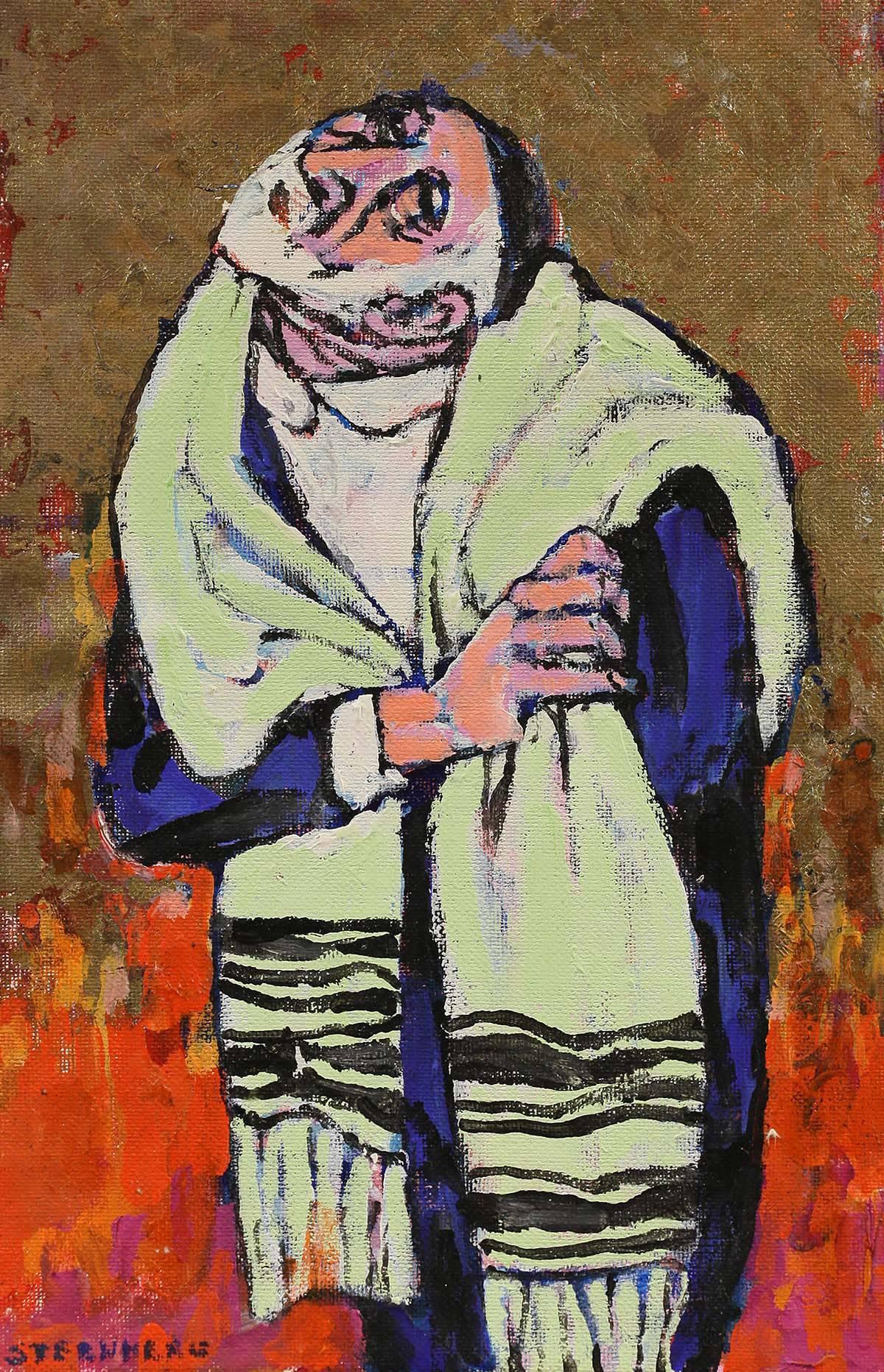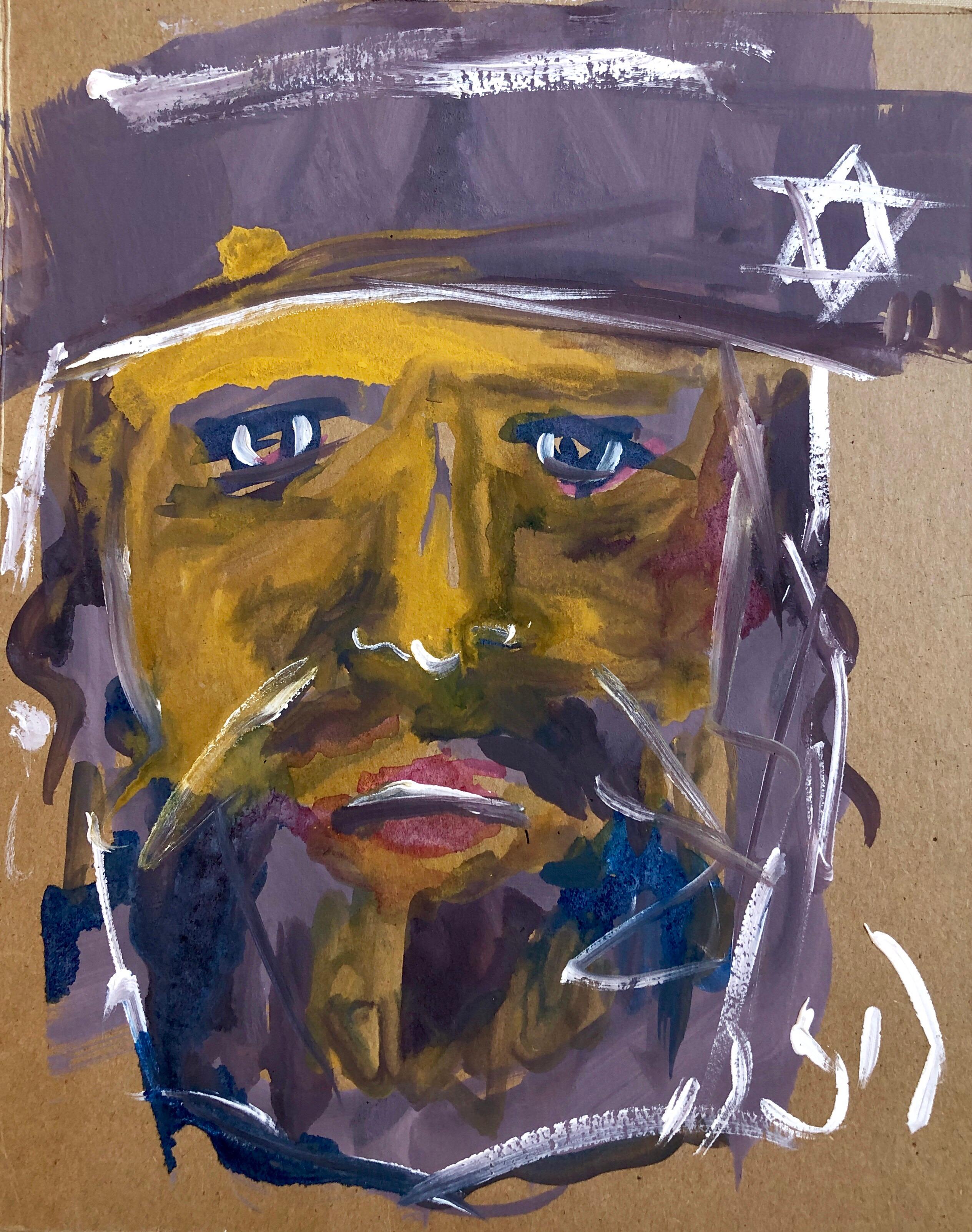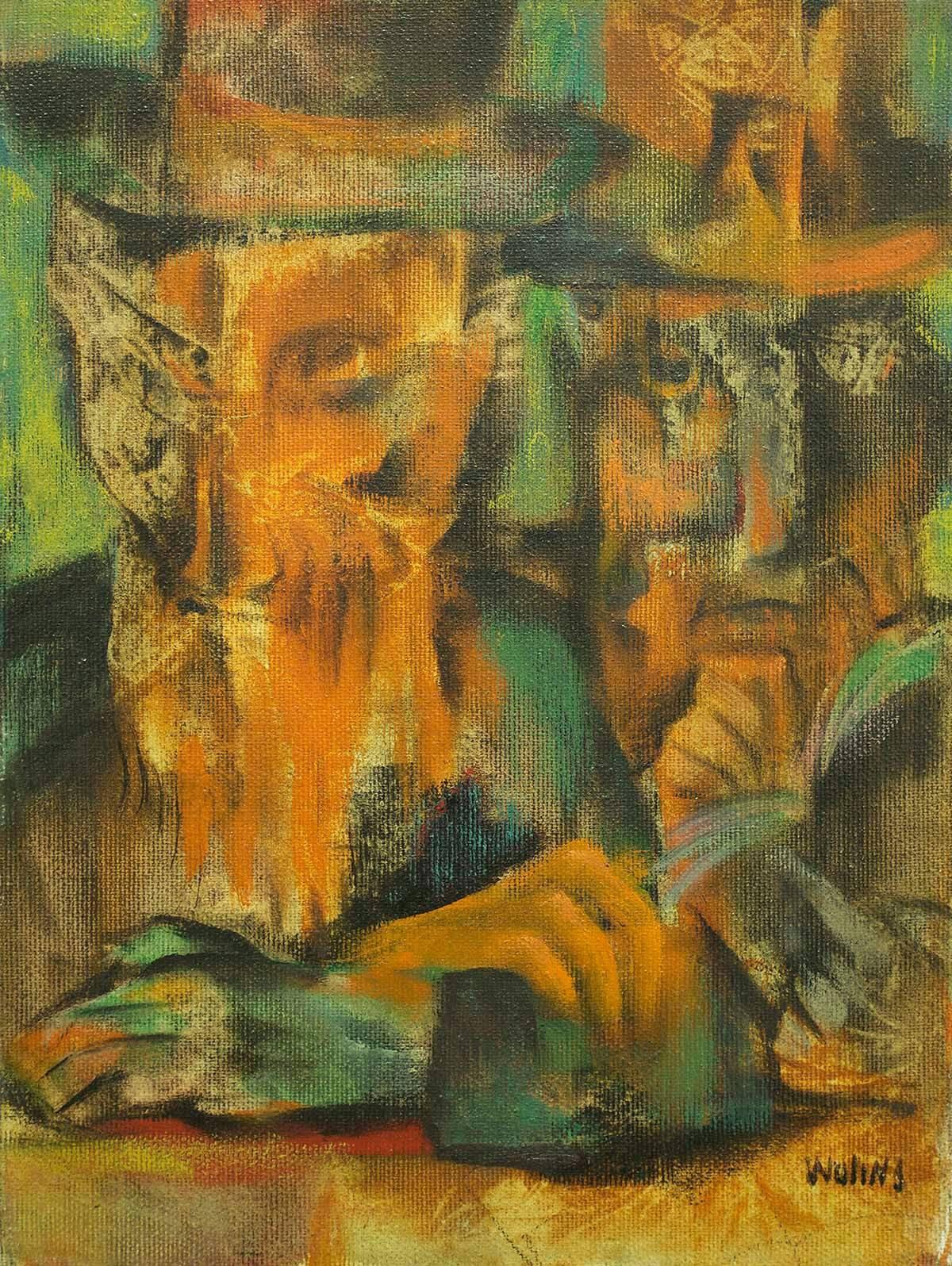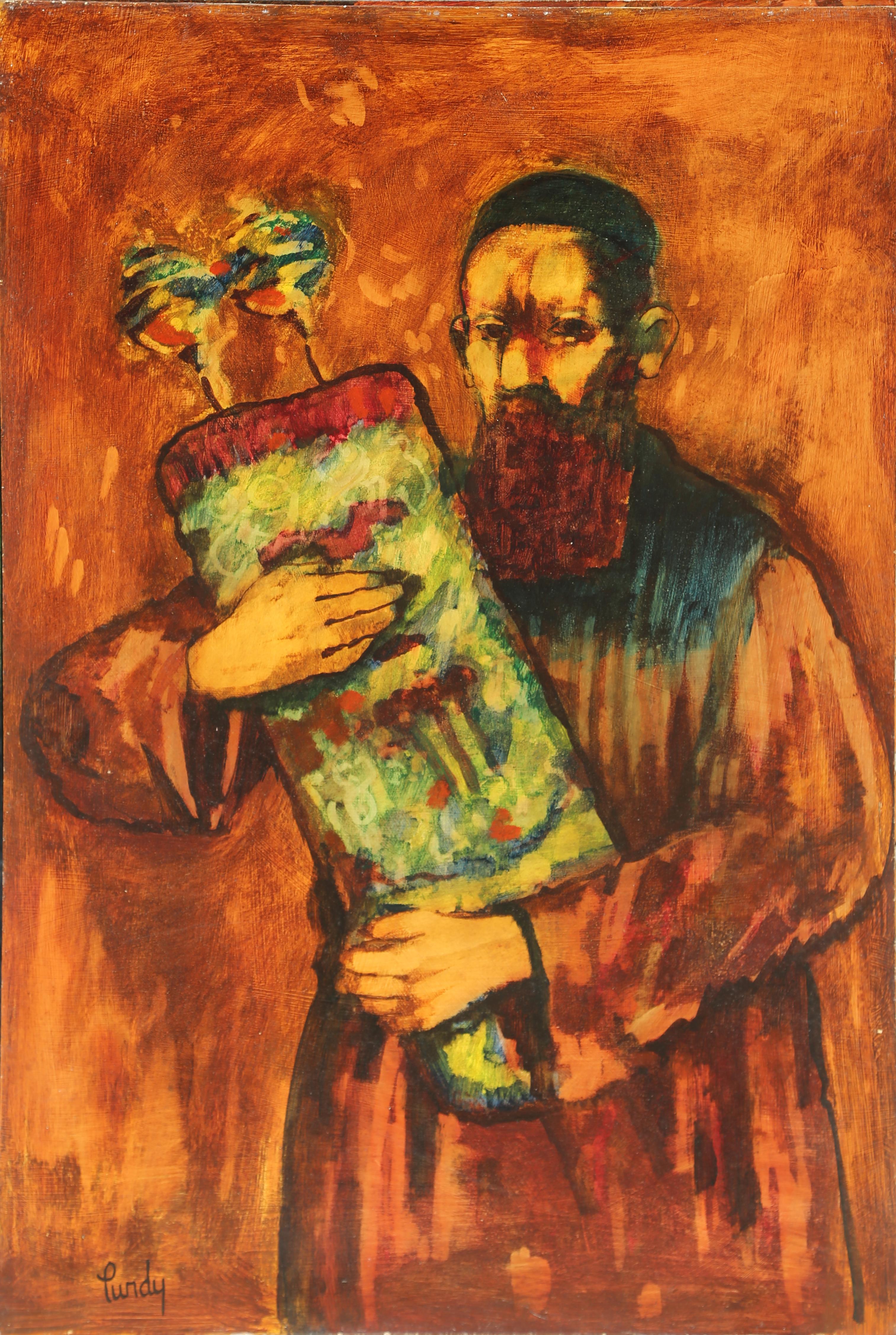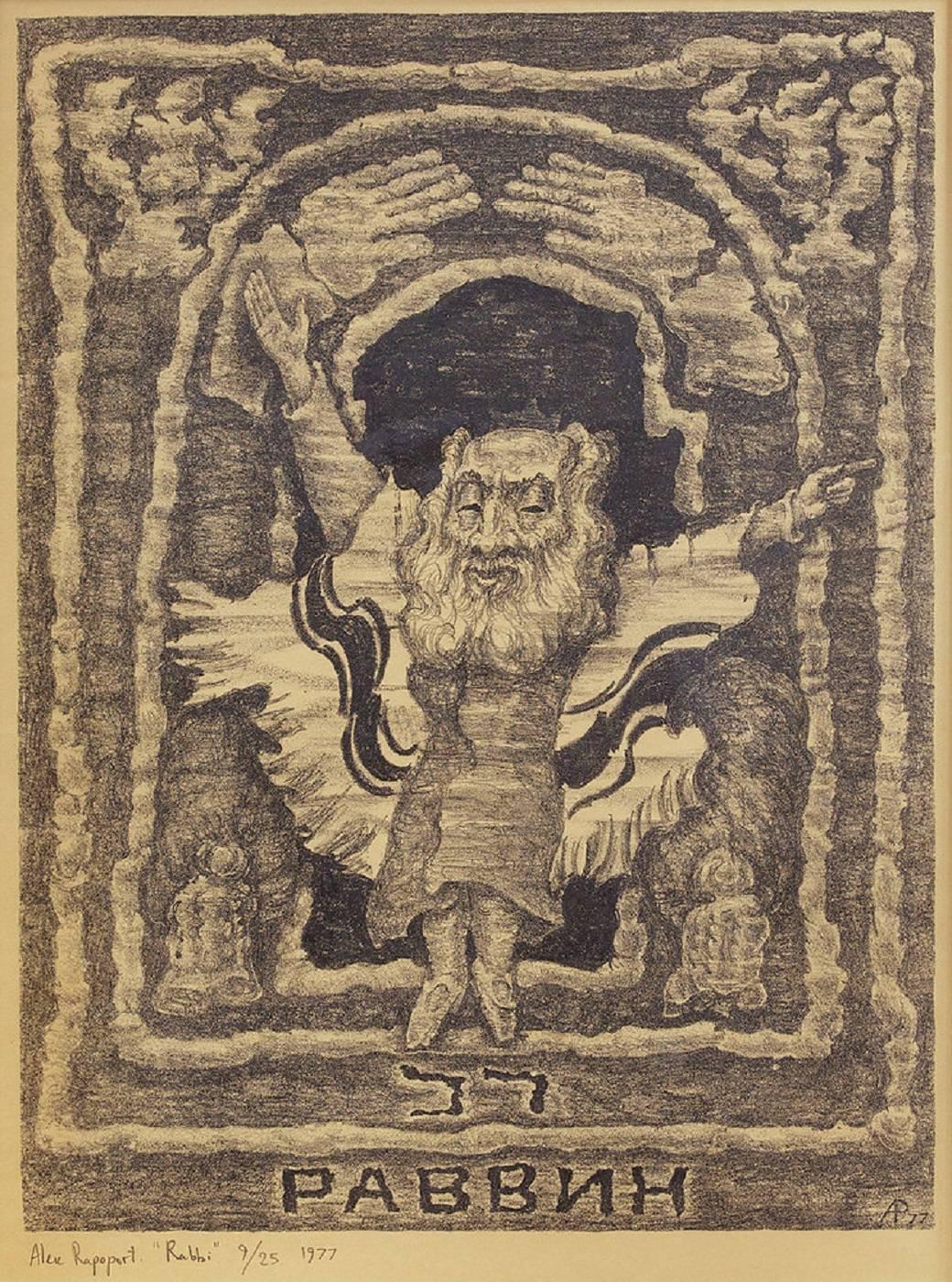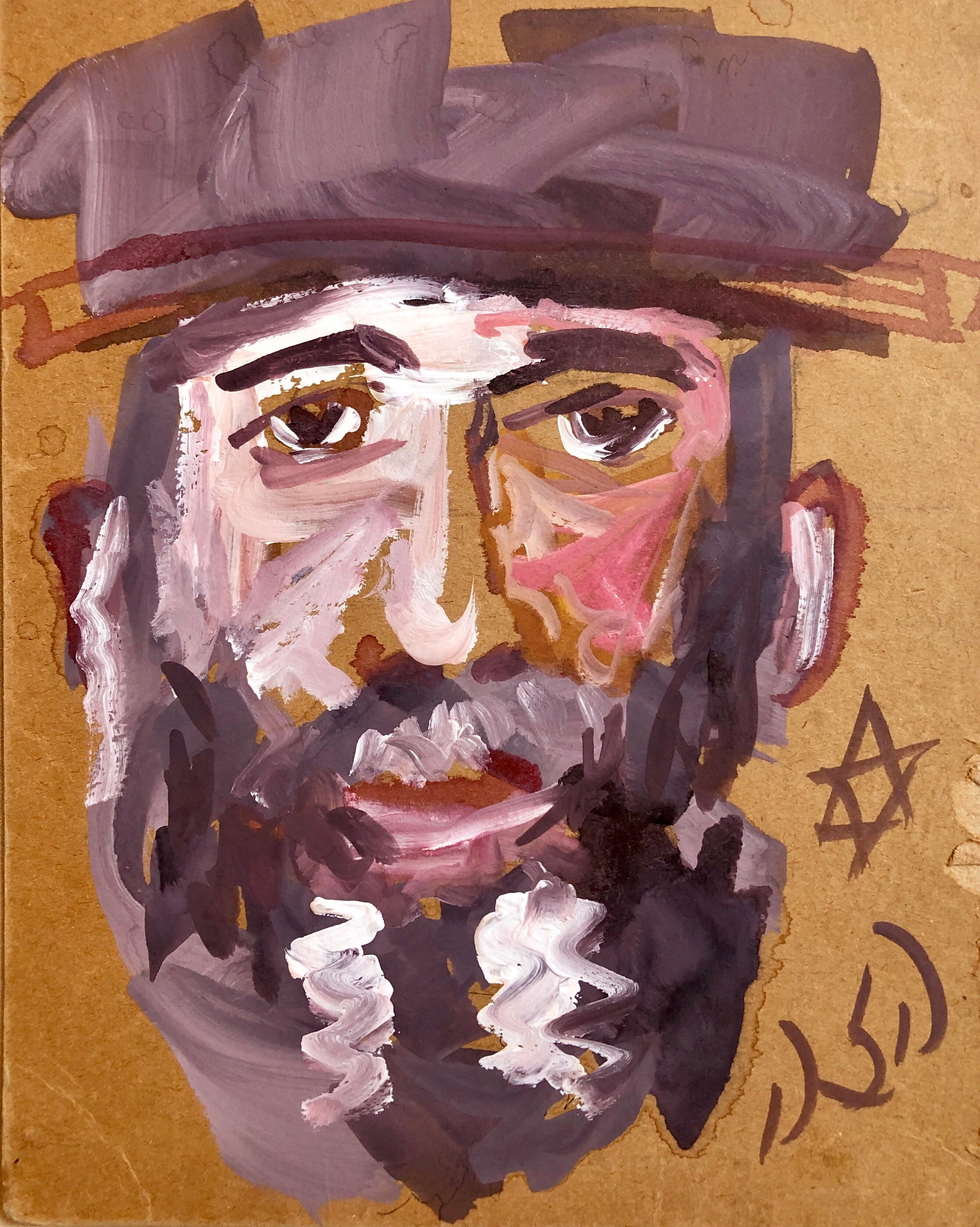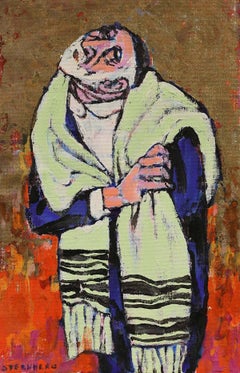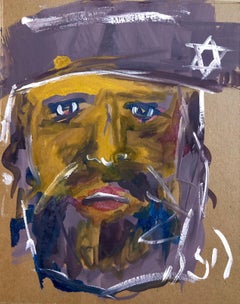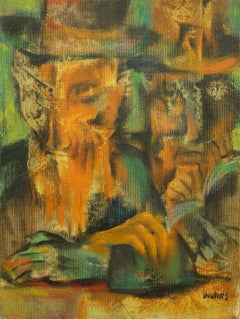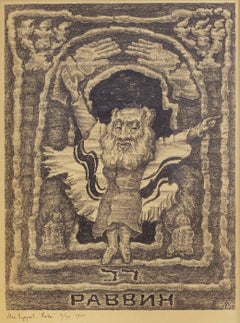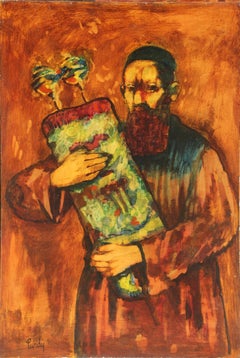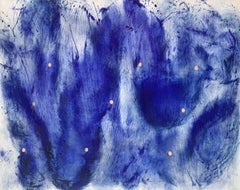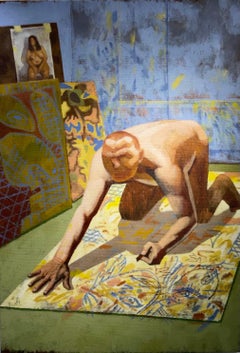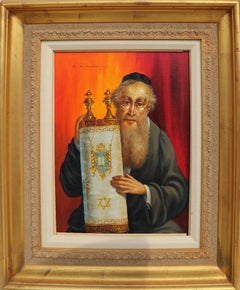Items Similar to Post Soviet Avant Garde RABBI, EXPRESSIONIST BLUE BACKGROUND, Yellow Star
Want more images or videos?
Request additional images or videos from the seller
1 of 5
Yuri BrusovanyPost Soviet Avant Garde RABBI, EXPRESSIONIST BLUE BACKGROUND, Yellow Star1992
1992
$3,000
£2,264.02
€2,591.96
CA$4,230.99
A$4,645.10
CHF 2,423.36
MX$56,212.23
NOK 30,373.07
SEK 28,619.42
DKK 19,348.27
About the Item
Genre: Judaica
Subject: Abstract
Medium: Oil
Surface: Canvas
Country: United States
Dimensions: 24" x 16"
Yuri Yefimovitch Brusovany was born on November,15th 1949 in Leningrad (St. Petersburg). His father was a Jew from Gomel. His mother descended from the prominent family of Samoiloff Actors. This family was well-known all over Russia for a long time. Since 1820 names of the actors from the Samoiloffs' Dynasty never left the theatre posters. It was the largest family tree in the history of Russian scenic art. The central figure in the dynasty was V.V. Samoiloff (1834 - 1877) lived at the same time with Feodor Dostoevsky, Karl Brullov and Leo Tolstoy. V.V. Samoiloff, P.V. Samoiloff and V.A. Michurina-Samoilova were buried at the Alexander Nevsky Monastery in St. Petersburg at the place where the greatest people of Russian Culture lay.
Yuri started painting in his early childhood. In 1962 - 1968 he studied at the Art School for gifted children at the Repin's Academy of Fine Art. In 1970 he became a student of Mukhina's (now, again, - Shtiglits) Academy of Decorative and Apply Art, specializing in monumental art. In 1975 he graduated from the Academy.
Yuri Brusovany had not been granted with official recognition until Perestroika. He was refused the membership in the Artists Union (altogether with the professional rights and privileges). In 1976 he joined the informal society of free artists in Leningrad (TEII). He chose the path of the decedents. Being a fierce antagonist to social realism, which was an official art theme in Soviet Union, he was pursued by the authorities, officially condemned and experienced a pressure from KGB's internal affairs. He was also in conflict with the soviet officials for his Bible, Hebrew and Jewish culture studies.
He took part in the exhibitions of the decedent artists in 1982, 1984, 1986, 1988. Fortunately, the political pressure gradually dissolved with Perestroika and Yuri can now enjoy a better environment.
1985 - His first personal exhibition took place at the Palace of Youth in Leningrad (St. Petersburg), Russia
1988 - He participated at the Exhibition of Free Russian Modern Arts Fund in Germany
1989 - Exhibition in Hettingen, Germany
1989 - Exhibition in Stockholm, Sweden
1990 - His Album ''Voices and Shadows'' was published by the Soviet Arts Fund
1991, 1999 - Personal exhibitions took place at the Smolny Cathedral in St. Petersburg, Russia
1999, 2000 - Personal exhibitions at Russian State Museum of Ethnography, St. Petersburg, Russia
2000 - Personal exhibition at the Russian House, Berlin, Germany
2000 - Personal exhibition at the Gallery ''Elite'', Dresden, Germany
Yuri's artworks are in private collections in France, Japan, Germany, Israel, Sweden, England, Russia, USA.
- Creator:Yuri Brusovany (1949, Russian)
- Creation Year:1992
- Dimensions:Height: 24 in (60.96 cm)Width: 16 in (40.64 cm)
- Medium:
- Movement & Style:
- Period:
- Condition:
- Gallery Location:Surfside, FL
- Reference Number:1stDibs: LU38211841952
About the Seller
4.9
Platinum Seller
Premium sellers with a 4.7+ rating and 24-hour response times
Established in 1995
1stDibs seller since 2014
1,810 sales on 1stDibs
Typical response time: 1 hour
- ShippingRetrieving quote...Shipping from: Surfside, FL
- Return Policy
Authenticity Guarantee
In the unlikely event there’s an issue with an item’s authenticity, contact us within 1 year for a full refund. DetailsMoney-Back Guarantee
If your item is not as described, is damaged in transit, or does not arrive, contact us within 7 days for a full refund. Details24-Hour Cancellation
You have a 24-hour grace period in which to reconsider your purchase, with no questions asked.Vetted Professional Sellers
Our world-class sellers must adhere to strict standards for service and quality, maintaining the integrity of our listings.Price-Match Guarantee
If you find that a seller listed the same item for a lower price elsewhere, we’ll match it.Trusted Global Delivery
Our best-in-class carrier network provides specialized shipping options worldwide, including custom delivery.More From This Seller
View AllModernist Rabbi Judaica Painting on Gold Background
By Harry Sternberg
Located in Surfside, FL
A contorted Rabbi looking upward is depicted in a naive, and almost child-like manner. Vibrant colors, and gestural brushstrokes fill the composition, enhancing the flatness of the figure.
Harry Sternberg, artist, teacher, and political activist was born in New York City's lower east side in 1904. He was the youngest of eight children born to his mother, a hungarian immigrant, and his father, an immigrant from Russia, .
His passion for art came early; by age 12 he had begun saturday art classes at the Brooklyn Museum of Art. Sternberg continued to advance his formal art education through 1922, studying at at New York's prestigious Arts Students League alongside Raphael Soyer, Yasuo Kuniyoshi and other notables of the day.
His career as a professional artist began in 1928 when he consigned a group of his early prints with the dealer Frederick Keppel in New York.
In 1933 he returned to the Art Students League of New York as an instructor, where he taught etching, lithography and composition, continuing to teach there for over 34 years.
During the Great Depression he was a WPA artist, and his murals are in post offices in Chicago, Chester and Sellersville, Pennsylvania.
Sternberg came to national prominence as a printmaker, painter, and muralist, in the Depression era and during World War II. Sternberg was an acclaimed member of a vital generation of American artists dedicated to exposing social injustices and offering support for an egalitarian society.
His interest in the plight of American workers...
Category
20th Century Modern Figurative Paintings
Materials
Acrylic, Illustration Board
Outsider Folk Art Expressionist Rabbi Israeli Painting Signed Hebrew Jewish Star
Located in Surfside, FL
This is a signed portrait painting done in an outsider, folk art, expressionist style. it is signed in Hebrew, also marked with a Jewish star. this is from a collection of works by the same hand. they are all signed. Some have markings to the back of the paper. they have some age to them. They bear similarities to artists as dissimilar as Moshe Tamir, Mane Katz and an Israeli version of Purvis Young. In this piece the artist choice of colors is muted yet powerful.
Israel has had a Vibrant Folk Art, Naive art scene for a long time now, artists like Yisrael Paldi, Nahum Guttman, Reuven Rubin and even Yefim Ladyzhensky had naive periods. The most well know of the strict naive artists are Shalom of Safed, Irene Awret, Gabriel Cohen, Natan Heber, Michael Falk and Kopel Gurwin.
Naïve art is any form of visual art that is created by a person who lacks the formal education and training that a professional artist undergoes (in anatomy, art history, technique, perspective, ways of seeing). Unlike folk art, naïve art does not necessarily evince a distinct cultural context or tradition. Naïve art is recognized, and often imitated, for its childlike simplicity and frankness. Paintings of this kind typically have a flat rendering style with a rudimentary expression of perspective.
One particularly influential painter of "naïve art" was Henri Rousseau (1844–1910), a French Post-Impressionist who was discovered by Pablo Picasso.
Naïve art is often seen as outsider art that is by someone without formal (or little) training or degree. While this was true before the twentieth century, there are now academies for naïve art. Naïve art is now a fully recognized art genre, represented in art galleries worldwide.
Museums devoted to naïve art now exist in Kecskemét, Hungary; Riga, Latvia; Jaen, Spain; Rio de Janeiro, Brasil; Vicq France and Paris. "Primitive art" is another term often applied to art by those without formal training, but is historically more often applied to work from certain cultures that have been judged socially or technologically "primitive" by Western academia, such as Native American, sub saharan African or Pacific Island art (see Tribal art). This is distinguished from the self-conscious, "primitive" inspired movement primitivism. Another term related to (but not completely synonymous with) naïve art is folk art.
There also exist the terms "naïvism" and "primitivism" which are usually applied to professional painters working in the style of naïve art (like Paul Gauguin, Mikhail Larionov, Paul Klee).
At all events, naive art can be regarded as having occupied an "official" position in the annals of twentieth-century art since - at the very latest - the publication of the Der Blaue Reiter, an almanac in 1912. Wassily Kandinsky and Franz Marc, who brought out the almanac, presented 6 reproductions of paintings by le Douanier' Rousseau (Henri Rousseau), comparing them with other pictorial examples. However, most experts agree that the year that naive art was "discovered" was 1885, when the painter Paul Signac became aware of the talents of Henri Rousseau and set about organizing exhibitions of his work in a number of prestigious galleries.
The Earth Group (Grupa Zemlja) were Croatian artists, architects and intellectuals active in Zagreb from 1929 to 1935. The group included the painters Krsto Hegedušić, Edo Kovačević, Omer Mujadžić, Kamilo Ružička, Ivan Tabaković, and Oton Postružnik, the sculptors Antun Augustinčić, Frano Kršinić, and the architect Drago Ibler. Art brut, primitive art, primitive, art naïf, naïve art. Outsider art. A term applied to Yugoslav (Croatian) naive painters working in or around the village of Hlebine, near the Hungarian border, from about 1930. Some of the best known naive artists are Dragan Gaži, Ivan Generalić, Josip Generalić, Krsto Hegedušić, Mijo Kovačić, Ivan Lacković-Croata, Franjo Mraz, Ivan Večenaj and Mirko Virius.
Camille Bombois (1883–1970) Ferdinand Cheval, known as 'le facteur Cheval' (1836–1924)
Henry Darger (1892–1973) L. S. Lowry (1887–1976) Grandma Moses, Anna Mary Robertson (1860–1961) Nikifor (1895–1968) Poland, Horace Pippin (1888–1946) Jon Serl (1894-1993) United States
Alfred Wallis (1855–1942) Scottie Wilson (1890–1972) Gesner Abelard (b. 1922) Jan Balet (1913–2009) Michel Delacroix (b. 1933) France Howard Finster (1916–2001) Ivan Rabuzin (1921–2008)
Spontaneous Art Museum in Brussels
Art en Marge Museum in Brussels
MADmusée in Liege
International Museum of Naive Art of Brazil in Cosme Velho, Rio de Janeiro
Gallery Jacques Ardies in São Paulo
Musée international d'art naïf de Magog in Magog
Croatian Museum of Naïve Art in Zagreb
Gallery of Croatian Naïve Art...
Category
20th Century Outsider Art Portrait Paintings
Materials
Gouache
The Kabbalists, Hassidic Rabbis Judaica Colorful Modernist Painting
By Joseph Wolins
Located in Surfside, FL
Joseph Wolins
1915-1999
Wolins was born in Atlantic City, New Jersey. He studied at the National Academy of Design from 1935 to 1941 under Leon Kroll. He also studied in Europe in ...
Category
20th Century American Modern Figurative Paintings
Materials
Canvas, Oil
The Rabbi 1977 Soviet Non Conformist Avant Garde Print
By Alek Rapoport
Located in Surfside, FL
Dimensions w/Frame: 25 3/4" x 20 3/4"
Alek Rapoport (November 24, 1933, Kharkiv, Ukraine SSR – February 4, 1997, San Francisco) was a Russian Nonconformist artist, art theorist and teacher.
Alek Rapoport spent his childhood in Kiev (Ukraine SSR). During Stalin's "purges" both his parents were arrested. His father was shot and his mother spent ten years in a Siberian labor camp. Rapoport lived with his aunt. At the beginning of World War II, he was evacuated to the city of Ufa (the Bashkir Autonomous Soviet Socialist Republic). A time of extreme loneliness, cold, hunger and deprivation, this period also marked the beginning of Rapoport's drawing studies.
After the war, Rapoport lived in Chernovtsy (Western Ukraine), a city with a certain European flair. At the local House of Folk Arts, he found his first art teacher, E.Sagaidachny (1886–1961), a former member of the nonconformist artist groups Union of the Youth (Soyuz Molodyozhi) and Donkey's Tail, popular during the 1910s–1920s. His other art teacher was I. Beklemisheva (1903–1988). Impressed by Rapoport's talent, she later (1950) organized his move to Leningrad, where he entered the famous V.Serov School of Art (the former School of the Imperial Society for the Promotion of Arts, OPKh, later the Tavricheskaya Art School).
His association with this school lasted eight years, first as a student, and then, from 1965 to 1968, as a teacher. With "Socialist realism" the only official style during this time, most of the art school's faculty had to conceal any prior involvement in non-conformist art movements. Ya.K.Shablovsky, V.M.Sudakov, A.A.Gromov introduced their students to Constructivism only through clandestine means.
(1959–1963) Rapoport studied stage design at the Leningrad Institute of Theater, Music and Cinema under the supervision of the famous artist and stage director N.P.Akimov. Akimov taught a unique course based on theories of Russian Suprematism and Constructivism, while encouraging his graduate students to apply their knowledge to every field of art design. Despite differences in personal artistic taste with Akimov, who was drawn to Vermeer and Dalí, Rapoport was influenced by Akimov's personality and liberalism, as well as the logical style of his art.
In 1963, Rapoport graduated from the institute. His highly acclaimed MFA work involved the stage and costume design for I.Babel's play Sunset. In preparation, he traveled to the southwest regions of the Soviet Union, where he accumulated many objects of Judaic iconography from former ghettos, disappearing synagogues and old cemeteries. He wandered Odessa in search of Babel's characters and the atmosphere of his books.
He organized a new liberal course in technical aesthetics, introducing his students to Lotman's theory of semiotics, the Modulor of Le Corbusier, the Bauhaus school, Russian Constructivism, Russian icons and contemporary Western art. As a result of his "radicalism," Rapoport was fired for "ideological conspiracy."
He sought to cultivate himself as Jewish artist. This became particularly noticeable after the Six-Day War, when the Israeli victory led intellectuals, including the Jewish intelligentsia, to feel a heightened interest in Jewish culture and its Biblical roots. Rapoport's works of this period include Three Figures, a series of images of Talmudic Scholars, and works dealing with anti-Semitism. In the 1970s Rapoport joined the non-conformist movement, which opposed the dogmas of "Socialist realism" in art, along with Soviet censorship. The movement sought to preserve the traditions of Russian iconography and the Constructivist/Suprematist style of the 1910s. Despite the authorities' persecutions of nonconformist artists (including arrests, forced evictions, terminations of employment, and various forms of routine hassling), they united in a group, "TEV – Fellowship of Experimental Exhibitions." TEV's exhibitions proved tremendously successful.
In the same period, Rapoport became one of the initiators of another anti-establishment group, ALEF (Union of Leningrad's Jewish Artists). In the United States this group was known as "Twelve from the Soviet Underground." Rapoport's involvement with this group increased tension with the authorities and attracted KGB scrutiny, including "friendly conversations," surveillance, detentions and house arrests. It became increasingly dangerous for him to live and work in the USSR. In October 1976, Rapoport with his wife and son were forced to leave Russia.
In Italy, Rapoport exhibited at the Venice Biennale, "La Nuova Arte Sovietica-Una prospettiva non-ufficiale" (1977), participated in television programs about nonconformist art in the Soviet Union, and created lithographic works continuing his theme of Jewish characters from Babel's play Sunset.
In 1977, Rapoport's family was granted U.S. immigration status and settled in San Francisco. a significant event in Rapoport's life occurred in his meeting with San Francisco gallery owner Michael Dunev, who became his friend and representative, organizing all his exhibitions until the artist's death.
Toward the end of the 1980s and beginning of the 1990s, Rapoport completed his most ambitious works on the theme of the Old Testament prophets: Samson Destroying the House of the Philistines (1989), Lamentation and Mourning and Woe (1990), the four paintings Angel and Prophets (1990–1991) and Three Deeds of Moses (1992).
In 1992, the artist's friends in St. Petersburg organized the first exhibition of his works there since his departure into exile, with works patiently gathered from collectors and art museums. This exhibition, held in the City Museum of St. Petersburg and accompanied by headlines such as "A St. Petersburg artist returns to his town," was followed by much larger ones in 1993 (St. Petersburg and Moscow), organized in collaboration with Michael Dunev Gallery under the name California Branches – Russian Roots.
He Exhibited in "Soviet Artists, Jewish Themes...
Category
1970s Post-Modern Figurative Prints
Materials
Lithograph
Outsider Folk Art Expressionist Rabbi Israeli Painting Signed Hebrew Jewish Star
Located in Surfside, FL
This is a signed portrait painting done in an outsider, folk art, expressionist style. it is signed in Hebrew, also marked with a Jewish star. this is from a collection of works by the same hand. they are all signed. Some have markings to the back of the paper. they have some age to them. They bear similarities to artists as dissimilar as Moshe Tamir, Mane Katz and an Israeli version of Purvis Young. In this piece the artist choice of colors is muted yet powerful.
Israel has had a Vibrant Folk Art, Naive art scene for a long time now, artists like Yisrael Paldi, Nahum Guttman, Reuven Rubin and even Yefim Ladyzhensky had naive periods. The most well know of the strict naive artists are Shalom of Safed, Irene Awret, Gabriel Cohen, Natan Heber, Michael Falk and Kopel Gurwin.
Naïve art is any form of visual art that is created by a person who lacks the formal education and training that a professional artist undergoes (in anatomy, art history, technique, perspective, ways of seeing). Unlike folk art, naïve art does not necessarily evince a distinct cultural context or tradition. Naïve art is recognized, and often imitated, for its childlike simplicity and frankness. Paintings of this kind typically have a flat rendering style with a rudimentary expression of perspective.
One particularly influential painter of "naïve art" was Henri Rousseau (1844–1910), a French Post-Impressionist who was discovered by Pablo Picasso.
Naïve art is often seen as outsider art that is by someone without formal (or little) training or degree. While this was true before the twentieth century, there are now academies for naïve art. Naïve art is now a fully recognized art genre, represented in art galleries worldwide.
Museums devoted to naïve art now exist in Kecskemét, Hungary; Riga, Latvia; Jaen, Spain; Rio de Janeiro, Brasil; Vicq France and Paris. "Primitive art" is another term often applied to art by those without formal training, but is historically more often applied to work from certain cultures that have been judged socially or technologically "primitive" by Western academia, such as Native American, sub saharan African or Pacific Island art (see Tribal art). This is distinguished from the self-conscious, "primitive" inspired movement primitivism. Another term related to (but not completely synonymous with) naïve art is folk art.
There also exist the terms "naïvism" and "primitivism" which are usually applied to professional painters working in the style of naïve art (like Paul Gauguin, Mikhail Larionov, Paul Klee).
At all events, naive art can be regarded as having occupied an "official" position in the annals of twentieth-century art since - at the very latest - the publication of the Der Blaue Reiter, an almanac in 1912. Wassily Kandinsky and Franz Marc, who brought out the almanac, presented 6 reproductions of paintings by le Douanier' Rousseau (Henri Rousseau), comparing them with other pictorial examples. However, most experts agree that the year that naive art was "discovered" was 1885, when the painter Paul Signac became aware of the talents of Henri Rousseau and set about organizing exhibitions of his work in a number of prestigious galleries.
The Earth Group (Grupa Zemlja) were Croatian artists, architects and intellectuals active in Zagreb from 1929 to 1935. The group included the painters Krsto Hegedušić, Edo Kovačević, Omer Mujadžić, Kamilo Ružička, Ivan Tabaković, and Oton Postružnik, the sculptors Antun Augustinčić, Frano Kršinić, and the architect Drago Ibler. Art brut, primitive art, primitive, art naïf, naïve art. Outsider art. A term applied to Yugoslav (Croatian) naive painters working in or around the village of Hlebine, near the Hungarian border, from about 1930. Some of the best known naive artists are Dragan Gaži, Ivan Generalić, Josip Generalić, Krsto Hegedušić, Mijo Kovačić, Ivan Lacković-Croata, Franjo Mraz, Ivan Večenaj and Mirko Virius.
Camille Bombois (1883–1970) Ferdinand Cheval, known as 'le facteur Cheval' (1836–1924)
Henry Darger (1892–1973) L. S. Lowry (1887–1976) Grandma Moses, Anna Mary Robertson (1860–1961) Nikifor (1895–1968) Poland, Horace Pippin (1888–1946) Jon Serl (1894-1993) United States
Alfred Wallis (1855–1942) Scottie Wilson (1890–1972) Gesner Abelard (b. 1922) Jan Balet (1913–2009) Michel Delacroix (b. 1933) France Howard Finster (1916–2001) Ivan Rabuzin (1921–2008)
Spontaneous Art Museum in Brussels
Art en Marge Museum in Brussels
MADmusée in Liege
International Museum of Naive Art of Brazil in Cosme Velho, Rio de Janeiro
Gallery Jacques Ardies in São Paulo
Musée international d'art naïf de Magog in Magog
Croatian Museum of Naïve Art in Zagreb
Gallery of Croatian Naïve Art...
Category
20th Century Outsider Art Portrait Paintings
Materials
Gouache
Post Soviet Avant Garde Judaica Rabbi Playing Violin (the Klezmer Fiddler)
By Yuri Brusovany
Located in Surfside, FL
Genre: Contemporary
Subject: People
Medium: Oil
Surface: Canvas
Dimensions: 24" x 18"
Yuri Yefimovitch Brusovany was born on November, 15th 1949 in Leningrad (St. Petersburg) Russia. His father was a Jew from Gomel. His mother descended from the prominent family of Samoiloff Actors. This family was well-known all over Russia for a long time. Since 1820 names of the actors from the Samoiloffs' Dynasty never left the theatre posters. It was the largest family tree in the history of Russian scenic art. The central figure in the dynasty was V.V. Samoiloff (1834 - 1877) lived at the same time with Feodor Dostoevsky, Karl Brullov and Leo Tolstoy. V.V. Samoiloff, P.V. Samoiloff and V.A. Michurina-Samoilova were buried at the Alexander Nevsky...
Category
1990s Expressionist Figurative Paintings
Materials
Canvas, Oil
You May Also Like
Rabbi, Oil Painting by Donald Roy Purdy
By Donald Roy Purdy
Located in Long Island City, NY
Artist: Donald Roy Purdy, American (1924 - )
Title: Rabbi
Year: circa 1960
Medium: Oil on Masonite, signed l.r.
Size: 36 x 24 in. (91.44 x 60.96 cm)
Category
1960s Post-War Figurative Paintings
Materials
Masonite, Oil
Silent stars. Gestural Abstraction, Blue, Gold, Polish artist
By Piotr Butkiewicz
Located in Warsaw, PL
Contemporary blue abstract oil on canvas painting by Polish artist Piotr Butkiewicz. Composition consists of dynamic rounded shapes. Title of this painting is 'Silent stars'. Artwork...
Category
2010s Abstract Expressionist Abstract Paintings
Materials
Canvas, Oil
Le chef d'oeuvre inconnu 2 - 21st Century, Male, Yellow, Blue, Contemporary Art
By Alexandru Rădvan
Located in Baden-Baden, DE
Le Chef d'oeuvre inconnu 2, 2022
acrylic on canvas
77 11/64 H x 53 5/32 W in.
196 H x 135 W cm
The work "The Unknown Masterpiece 2" (a paraphrase of Balzac's novella – Le Chef d’oeu...
Category
2010s Contemporary Nude Paintings
Materials
Canvas, Acrylic
Rabbi and Torah, Oil Painting by Abraham Straski
By Abraham Straski
Located in Long Island City, NY
Artist: Abraham Straski, Polish (1903 - 1987)
Title: Rabbi and Torah
Year: circa 1957
Medium: Oil on Canvas, signed l.r.
Image Size: 16 x 12 inches
Frame Size: 26 x 20 inches
Category
1950s Post-War Portrait Paintings
Materials
Canvas, Oil
Man and the Moon
By Nahum Tschacbasov
Located in Southampton, NY
Oil on canvas. Signed lower right Tschacbasov. Original painting by Nahum Tschacbasov. Condition is excellent. Presently unframed. Provenance: Estate of the artist Nahum Tschac...
Category
1970s Post-Modern Abstract Paintings
Materials
Canvas, Oil
$6,800 Sale Price
69% Off
Rabbi with Torah, Oil Painting by Abraham Straski 1950
By Abraham Straski
Located in Long Island City, NY
Rabbi with Torah
Abraham Straski, Polish (1903–1987)
Date: 1950
Oil on Canvas on Wood, signed and dated
Size: 16 x 12 in. (40.64 x 30.48 cm)
Frame Size: 19.5 x 15.5 inches
Category
1950s Post-War Portrait Paintings
Materials
Canvas, Oil, Wood
